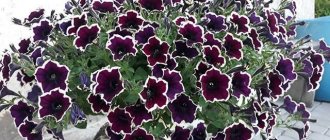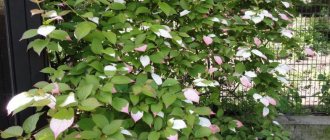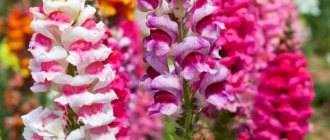Don't have time to read the article? Watch the video!
First, a little theory. Plants intended for planting in the ground or outdoor flowerpots are perennial and annual. Sometimes it depends not on the variety, but on the climate. Some flowers grow well for two years or more in warm regions, but in central Russia they are almost impossible to save during cold weather.
- Landscape
We choose the most unpretentious flowers for the garden: 23 suitable types
Petunia
A favorite among gardeners both in our country and abroad. It can survive in almost any soil if the seedlings are healthy and strong. It is very difficult to grow these from seeds yourself, so it is better to buy ready-made, grown ones.
Petunia can be planted outside in March, as it is not afraid of light frosts. Blooms continuously from April until late autumn. In the southern regions you can find blooming petunia even in November.
Seeds SEARCH Petunia ampelous Opera Lilac
The plant feels great in the sun, but if it is not possible to water at least every other day, it is better to arrange a flower garden in partial shade. But strong shade is contraindicated - the seedlings will quickly weaken and may die. Petunia is an annual plant, but craftsmen manage to save it for the second year.
Photo: Instagram altpark
Photo: Instagram love_flowers_on
Photo: Instagram lary_ela
Photo: Instagram irinanazarovaperm
- Landscape
Unusual flowers for your garden: 7 varieties that you won’t see among your neighbors
Hydrangea
Large balls and panicles of hydrangea leave no one indifferent. Moreover, all types of hydrangea are good in gardens: tree-like, oak-leaved, paniculate, large-leaved, etc. Even one flowering bush of this plant will make the garden attractive, and a whole hedge will make it the most comfortable place in your summer cottage.
- Popular types and varieties of garden hydrangeas
8 types of hydrangea for your garden + proven varieties.
- 8 most important questions about planting and caring for hydrangeas
Simple step-by-step instructions on how to grow an unpretentious and beautiful hydrangea.
Marigold
Also known under the Ukrainian name “chornobryvtsi”. They came to us from America, and now it’s hard to imagine a Russian dacha without them. And all because this is perhaps the easiest plant to care for, even for a beginner. By the way, they are easy to grow from scratch. You can start the sowing campaign in early spring, but it is better to do it indoors. At the end of April - beginning of May, marigolds are no longer afraid of open ground. But if there is a threat of frost, it is better to cover them with film.
In the open sun, marigolds bloom most magnificently. But, as with petunias, if it is not possible to water frequently, it is better to choose partial shade. They bloom until autumn and then “die”. But you can collect the seeds and grow them next year.
Photo: Instagram vovchik_dik
Photo: Instagram anna1_knyazeva
- Landscape
10 best garden shrubs that bloom with white flowers
tree peony
These beautiful and fragrant flowers with a large number of petals are located on a high bush and become a decoration of the garden before their “brothers”. The buds can come in a variety of shades, but pale pink, crimson, red and purple are especially popular in gardens.
- 9 fantastically beautiful varieties of tree peony
Magnificent peonies that will take your breath away!
- Tree peonies - planting and care
Don't know how to plant and grow a tree peony? We'll tell you!
Purslane
And this plant lives without shade or watering in the heat for as long as desired. Even the popular name “midday heat” speaks about this remarkable quality. Small bright flowers open their petals at ten o'clock in the morning and close at dusk. It spreads beautifully like a carpet over the lawn and is also suitable for hanging flowerpots.
Photo: Instagram my_own_paradise4142
Photo: Instagram guslica
Photo: Instagram _ania_b_
Photo: Instagram zarema_151008
- Landscape
9 garden plants that will make your 5 acres visually larger
Ground cover perennial long-blooming flowers
Ground cover plants can be seen in any garden. They hide the imperfections of the flowerbed, act as a contrast for tall plants, and cover empty areas with a thick multi-colored carpet. The soil, covered with a carpet of groundcover perennials, remains moist and does not dry out. Weeds cannot break through the dense carpet of plants. In addition to all these advantages, ground cover plants are unpretentious. That's why flower growers love them.
Unpretentious ground cover plants that bloom for a long time include:
- coin loosestrife;
- creeping thyme;
- phlox subulate;
- bryozoan;
- periwinkle;
- herbal cloves;
- capitate knotweed “Amethyst crumb”;
- peg;
- Aubrietta.
Lavender
An unpretentious evergreen ornamental shrub, popular not only for its blue or purple spike-shaped flowers, but also for its persistent, refined aroma. When planted in groups, the effect of a continuous “blanket” is obtained, for which this plant is especially favored by lovers of atmospheric photos. Some varieties bloom from early summer to autumn, while others bloom from April to July, and then produce a second wave of flowering in September.
Seeds Gavrish Medicinal series Lavender Voznesenskaya
An open area is optimal for lavender, and watering in hot weather is about twice a week.
Photo: Instagram _sleepy_apple_
Photo: Instagram lrinakachanova
Photo: Instagram pinacolada_garden
- Landscape
7 most beautiful climbing flowers for the garden
Protea artichoke
This evergreen shrub (1-3 m high) with leathery leaves and large hairy flowers (up to 30 cm in diameter), collected in cone-shaped inflorescences, lives in Africa. The protea flower is the national symbol of the Republic of South Africa. It is not easy to grow this exotic beauty in the middle zone, because it does not tolerate cold. Therefore, in our latitudes it is exclusively an indoor or greenhouse crop. From spring to mid-autumn, the plant is provided with a temperature of about 20°C, and in winter – from 5 to 10°C. Without wintering in a cool room, the protea will not bloom next season.
Nasturtium
It can be perennial or annual, and in appearance it is bushy, dwarf, creeping with a stem length of up to 4 m. Most varieties bloom from June to October. It needs regular watering only after moving to open ground. This usually happens in early June. When the nasturtium gets stronger, it is enough to water it as the soil dries out: excess moisture stimulates the abundant growth of greenery to the detriment of flowering.
Photo: Instagram best_family_garden
Photo: Instagram natali290669
- Landscape
What flowers to plant in the ground in spring: 10 suitable types
Decorative indoor plants
Growing beautifully flowering plants in pots began to be practiced back in the era of the Great Geographical Discoveries. Today, caring for indoor plants is a passion for millions of people around the world.
Flowers vary in shape, color and foliage characteristics and may be of local or distant origin. In any case, in the bustle of the city, they remind you of the enchanting delights of nature.
Snapdragon
This annual is popular due to its rich colors and delicate aroma. It blooms all summer and part of autumn - until the onset of frost. The variety of species (there are dwarf, low-growing, medium-growing, tall varieties) allows you to play with the design of flower beds and plant these plants in various corners of the garden. In its classic form, known for over 500 years, snapdragon is an erect plant. But breeders also developed hanging ones with long shoots - for window boxes or hanging baskets.
Photo: Instagram workshop_pattern_of_taatta_
Photo: Instagram larissa53
Photo: Instagram altair2015astrackan
- Landscape
10 signs of a would-be gardener who will ruin his entire harvest (check yourself)
Calla
Calla, or zantedeschia, is attractive with its large leaves and unusual flower shape. Each flower remains presentable for about a month. Only 3 types of calla lilies are found in culture:
- Ethiopian (the flowers of these tall white callas reach 8-15 cm);
- Remanna (plant up to 70 cm high with flowers of pink and lilac shades);
- Eliotta (a flower up to 50 cm high with large green speckled heart-shaped leaves and predominantly yellow flowers).
For the winter, calla lily tubers are dug up and stored in a dry and dark room at a temperature of about 5°C.
Of course, to accommodate such large plants, you need to have sufficient space. But for the sake of such beauty, you can try to free up space. Do you grow giants in your garden or do you prefer miniature and delicate flowers?
Duchesnay
This unusual plant is often confused with... strawberries. It really resembles it both in leaves and “fruits”. This is what people call it: “false strawberry.”
The flowering period is short, the flowers themselves are yellow and inconspicuous, but they look beautiful against the background of a green carpet. By the way, this carpet does not lose its attractiveness all summer long; it spreads across the dacha area, but does not weave everything in a row. The berries that form after flowering are not poisonous, but tasteless, so throughout the summer season they serve only a decorative function. Duchesnea looks “like a cucumber” in the sun, even with extremely rare watering. So this is a great option for those who rarely visit their country house.
Photo: Instagram maman.vs
Photo: Instagram photo_trip_sochi
Photo: Instagram filifionka_annet
- Landscape
How to make a flowerbed that does not require complex care: 5 practical tips
Tall fall-blooming perennials
Perennials, whose flowering period occurs in autumn, will help prolong the flowering of a garden flower bed in the autumn.
Boltonia
An unpretentious perennial with medium-sized, simple-shaped flowers, it begins to bloom in mid-summer. And it pleases the eye until the first frost. Boltonia is unpretentious and quickly grows into a lush bush up to 2 meters high. Grows in sunny areas and in partial shade, without requiring additional care.
Anemone hybrid
The plant has an attractive and original appearance thanks to delicate flowers located on thin stems and carved leaves. Anemone is not demanding on soil composition and watering, and tolerates temperature changes well. Therefore, it is distinguished by long flowering in the autumn.
Chrysanthemum
Magnificent chrysanthemums are distinguished by a variety of varieties and resistance to low temperatures. They will decorate the garden until the frosts. Their advantages include the ability to retain their appearance in a bouquet for a long time after cutting.
Chrysanthemum is not a capricious plant; it grows quickly, forming a lush bush. The height of the bush depends on the variety. There are bushes up to 1.7 meters tall.
Rudbeckia
Yellow tall perennial flowers are popularly known as golden balls. They bloom in early autumn, flowering continues until frost.
The height of rudbeckia reaches 2 meters. Any place in the garden is suitable for planting, regardless of the light level and soil composition. Golden balls do not require additional care. The transplant period is on average 5 years.
Calendula
For many, this is a country must-have, just like marigolds and petunias. And not only due to its medicinal properties. Its decorative component is also excellent.
If you sow calendula in the ground in late autumn, it will withstand frosts down to minus 5°C, and in the spring it will bloom very early. Then it will reproduce on its own in the sunniest places; it only needs to be thinned out and planted. You don’t have to bother with frequent watering - calendula tolerates a long absence of moisture well.
Photo: Instagram victoriaorlova_
- Landscape
16 plants that can still be planted in August at the dacha
Drought-resistant perennial flowers
Drought-resistant flowers do not require watering at all or for a long time. Such flowers can be grown without fear that they will dry out if there is no moisture for a long time. They cannot be called super beautiful, but they are quite decorative and brighten up the garden. Drought-resistant plants can be considered:
- lavender;
- yarrow;
- snowhead;
- rudbeckia shiny;
- Carpathian bells;
- sedum;
- young;
- mountain cornflower;
- phlox subulate;
- cloves
Ageratum
It enlivens the landscape with its colorful inflorescences, which look like fluffy pompoms consisting of many small flowers. Their palette is impressive - experts count about 50 shades!
Seeds Gavrish Garden of Fragrances Ageratum White Bouquet
Ageratum blooms for about three months: either from May to July, or from June to August, depending on the climate. Suitable for creating “carpets”, compositions in pots, living borders. It rots from excess moisture, so very moderate watering is required.
Photo: Instagram home_gardens
Photo: Instagram sannata_teddy
Photo: Instagram anna1_knyazeva
- Country cottage area
What can be planted at the dacha in June: vegetables, herbs and flowers
Buddleya David
This plant is also notable for its large and numerous inflorescences. Buddleia is a deciduous shrub that blooms for 45 days. The flowers come in a variety of colors, and they all exude a honey aroma. For this reason, the plant is often called a “butterfly magnet.” Buddleia Davida can withstand frosts down to –20°C and looks great in groups against the backdrop of lawns and in mixed borders. These flowers are good to use to camouflage outbuildings or pipes, as well as to create a hedge.
Phloxes
Phlox will fit into the shaded areas of the dacha, where groundwater comes close to the surface. They love high humidity and coolness. And in the sun they quickly lose their decorative appearance. Subject to these basic conditions and the right choice of soil - without clay, with the addition of lime, with an average humus content - the bushes can grow for many years without special care and not lose their attractiveness.
Photo: Instagram kirykik
- Decoration
7 climbing plants you can easily grow in your apartment
Photos and names of perennial unpretentious flowers that bloom all summer from May to September
Perennials are plants that do not need to be replanted every season. Their root system tolerates winter well and produces new growth in the spring. Perennials have a number of advantages, the main ones of which are:
- good winter hardiness;
- the ability to reproduce well;
- variety of species;
- long flowering period;
- ability to grow without transplantation for many years;
- low maintenance requirements.
Perennials, however, are more susceptible to root diseases than annual plants.
To create a flower bed that does not require special care, perennials are most suitable. Once you have completed all the plantings, you can enjoy a beautiful flower garden for several years. I recommend learning the basic rules for forming a flower bed from the article “What flowers to plant in a flower bed so that they match in color and height.”
To simplify the formation of a flower bed according to the color of perennials, you can turn to monochrome flower beds. In this case, you will get unusual stylish flower beds, and there will be no problems with an unsuccessful color combination.
Yellow
Flower beds made up of yellow flowers that bloom all summer lift your spirits and charge you with energy.
Perennials in yellow tones can be represented by:
- coreopsis;
Coreopsis. - rudbeckia;
Rudbeckia. - St. John's wort;
St. John's wort. - heliopsis; Heliopsis.
- astilbe;
Astilbe. - daylily;
Day-lily. - ordinary cuff;
The cuff is ordinary. - loosestrife
Loosestrife.
Flower beds in yellow tones are distinguished by the brightness of their colors. People who choose yellow are optimistic and radiate vitality. It is easy and pleasant to communicate with them.
Blue
The color blue symbolizes dreaminess and hope. Blue flower beds evoke pleasant thoughts, calm, and put you in a lyrical mood. In a blue flower garden you can plant:
- lavender;
Lavender. - blue chamomile;
Blue chamomile. - cornflower;
Cornflower. - phlox;
Phloxes. - delphinium;
Delphinium. - lupine;
Lupine. - periwinkle;
Periwinkle. - loosestrife;
Loosestrife. - oak sage.
Oak sage.
Blue flower beds are chosen by dreamers and romantics.
Daylilies
These luxurious flowers were the heroes of legends, poems and novels many centuries ago, but to this day their popularity has not waned. New varieties appear every year, and in total about 70 thousand have already been bred.
The rules of care are simple: watering, periodically loosening the soil and occasionally weeding. Powerful roots can get water from the depths, so these plants tolerate drought very easily.
In good weather they bloom all summer. But they can also “take off their outfit” if prolonged rains begin or cold weather sets in for a long time. They live quietly in one place for several years, and it is recommended to replant them no later than August, so that they have time to take root before the cold weather.
Photo: Instagram irina_cherevko1010
Photo: Instagram flowers_the_world_is_beautiful
Photo: Instagram kattya_._
- House plants
How to replant plants correctly: instructions in 4 steps
Giant water lily
Victoria Amazonis is the largest nymph in the world. This is the national flower of Guyana, depicted on the coat of arms of this state. The giant water lily grows well in bright sunlight in water at a depth of at least 1 m. The minimum temperature for proper plant development is 25 ° C, so in the unstable climate of the middle zone it is difficult to obtain this huge flower. However, among the representatives of the Nymphaeaceae family there are many less fastidious plants, and they are also distinguished by their large “dimensions”.
- Nymphea - the best varieties with photos, planting and care
Everything you wanted to know about growing water lilies.
- 7 possible reasons why nymphs do not bloom in a pond
These 7 annoying mistakes will deprive you of abundant flowering of your water lily. However, fixing them is easy.
Pelargonium
Known since Soviet times as indoor geranium, but in recent years it has become widespread in landscape design. Blooms with bright umbrellas in the heat or partial shade. Close proximity to groundwater is undesirable so that the plant does not rot. It responds well to pinching shoots, loosening the soil and very dosed watering. Pelargonium is a perennial, but to be on the safe side for the winter, it is transplanted into a pot and taken from the street.
Photo: Instagram geranivkazani
Photo: Instagram home_gardens
Photo: Instagram elviracvety
- Landscape
10 flowers that will grow even where nothing grows
What unpretentious long-flowering perennials grow in the regions of Russia?
The main problem for unpretentious perennial flowers is the cold winter, during which the roots of the plants may die. If you don’t want to bother yourself with covering your plants for the winter, then you should choose varieties that are suitable for frost resistance for your climate.
In Siberia
Many long-blooming, unpretentious perennial flowers grow well in Siberian gardens and tolerate cold winters well. In Siberia you can plant:
- crocuses;
- daffodils;
- tulips;
- muscari;
- irises;
- peonies;
- lilies;
- sedum;
- aquilegia;
- Highlander;
- phlox;
- chrysanthemums.
In the Urals
In addition to unpretentious, long-blooming perennial flowers that grow well in Siberia, they feel great in the Urals:
- phlox;
- periwinkle;
- cuff;
- clove grass;
- Turkish cloves;
- chamomile;
- day-lily;
- mountain cornflower;
- yarrow;
- astilbe;
- rudbeckia;
- echinacea;
- delphinium;
- rose stock;
- imperial hazel grouse.
In outskirts of Moscow
For the relatively warm climate of the Moscow region, you can select a large number of unpretentious and long-flowering perennials. In addition to the examples listed above for the Urals and Siberia, we can recommend:
- herbaceous peony;
- primrose;
- Phlox paniculata;
- garden bells;
- buzulnik;
- aster;
- decorative bows;
- thyme;
- tenacious;
- clean.
Matthiola bicornuum
She looks modest, and only blooms in the evenings. But it is loved for its strong sweet aroma and durability in spartan conditions. This is the case when you can sow a plant, forget about it, and find it a couple of months later by smell.
Seeds SEARCH Matthiola bicorna Lilac-pink
However, the plainness of flowers does not prevent gardeners from creating delicate, minimalist compositions, for example, in combination with stones.
Photo: Instagram zeleno.tyt
Photo: Instagram __tanya__ivanova__
Photo: Instagram zhiznakamnyah
Photo: Instagram olyamitskevich
- Landscape
10 beautiful flowers that will bloom in your garden even without care
Lily hybrid
Restless breeders do not stop there and produce more and more new hybrid plants. Recently, Asian and Oriental lily hybrids (OT, OA, LO, LA) have become especially popular. These plants have large and numerous flowers, and the flowering period can last several months.
- 8 Best Varieties of Asiatic Lilies
The most attractive Asiatic lilies: detailed description of varieties with photos.
- OT and LA hybrids of lilies: everything you wanted to know about them
How do modern LA and OT hybrids differ from species lilies and other varietal groups of this wonderful flower?
One of a Kind
Darmera peltata (Darmera peltata) looks unusual under the canopy of trees Like all clump perennials, it grows well. In the spring, before the leaves appear, against the background of bare ground, its pink-red spherical flowers on a high (50 cm) peduncle are magnificent. In summer, Darmera attracts attention with its succulent round shield leaves with a notched edge on high (75–85 cm) petioles. In this case, individual leaves reach 40 cm in diameter. And in autumn they turn red-orange. Peltiphyllum is also very beautiful in coastal compositions. It can be damaged by return frosts, but quickly restores its shape. Grows well in loose, moist and fairly fertile soils.
Another single representative of its genus is Astilboides tabularis. Sometimes in garden centers it is found under the old name - Rogersia lamellar. The plant has truly huge, hard, round leaves up to 60 cm in diameter, similar to darmera leaves, but absolutely flat, without a funnel at the petiole. This giant is beautiful in all stages of development, and especially in June - early July, when a creamy-white panicle resembling astilbe appears on a high peduncle. On moist soil in a shady place, a small seedling in two years will turn into a hero, covering a square meter of garden area.











